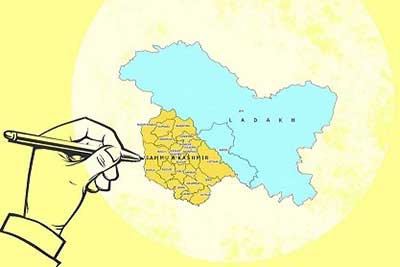Relevance: GS-2, Statutory, regulatory and various quasi-judicial bodies.
Key phrases: 84th Constitutional Amendment, delimitation, outmigration, Census, Boundary Commission
Why in News?
- In 2001, the 84th Constitutional Amendment extended the freeze on the number of constituencies by another 25 years – to 2026.
- As 2026 is approaching, it is important that issues and challenges that the next round of delimitation will pose should be looked into.
- The most glaring factor is that of asymmetry among states with regard to the number of MPs in the Lok Sabha.
- There is also an issue of massive outmigration of SCs and STs to urban areas, where their numbers are so dispersed that reserving constituencies for them becomes difficult.
Delimitation:
- Delimitation literally means the act or process of fixing limits or boundaries of territorial constituencies in a country or a province having a legislative body. The job of delimitation is assigned to the Delimitation Commission or a Boundary Commission.
- The Delimitation Commission in India is a high-power body whose orders have the force of law and cannot be called in question before any court. These orders come into force on a date to be specified by the President of India on this behalf. The copies of its orders are laid before the House of the People and the State Legislative Assembly concerned, but no modifications are permissible therein by them. (Art 329. Bar to interference by courts in electoral matters Notwithstanding anything in this Constitution (a) the validity of any law relating to the delimitation of constituencies or the allotment of seats to such constituencies, made or purporting to be made under Article 327 or Article 328, shall not be called in question in any court)
Procedure for delimitation:
- Under Article 82 of the Constitution, the Parliament by law enacts a Delimitation Act after every census. After coming into force of the Act, the Central Government constitutes a Delimitation Commission.
- The Constitution of India was specifically amended in 2002 not to have delimitation of constituencies till the first census after 2026. Thus, the present Constituencies carved out on the basis of 2001 census shall continue to be in operation till the first census after 2026.
- The Delimitation Commission is appointed by the President of India and works in collaboration with the Election Commission of India. Composition:
- Retired Supreme Court Judge
- Chief Election Commissioner
- Respective State Election Commissioners
- Allocation of seats for Scheduled Castes and Tribes in the Lok Sabha are made on the basis of the proportion of Scheduled Castes and Tribes in the State concerned to that of the total population, vide provision contained in Article 330 of the Constitution of India read with Section 3 of the R. P. Act, 1950.
Delimitation in J&K
- Assembly seats in J&K were delimited in 1963, 1973 and 1995.
- Prior to August 5, 2019, carving out of J&K’s Assembly seats was carried out under the J&K Constitution and Jammu and Kashmir Representation of the People Act, 1957.
- Until then, the delimitation of Lok Sabha seats in J&K was governed by the Constitution of India.
- However, the delimitation of the state’s Assembly was governed by the J&K Constitution and J&K Representation of the People Act, 1957.
- There was no census in the state in 1991 and hence no Delimitation Commission was set up by the state until 2001 census.
Concerns raised over Delimitation
- Jammu vs. Kashmir: Concerns had been expressed over how the
delimitation process may end up favoring the Jammu region over Kashmir in
terms of the seats.
- A Delimitation Commission was established under Justice Ranjana Desai to delimit constituencies in J&K on the basis of the 2011 census.
- Based on this, Jammu will have 43 and Kashmir will have 47 seats in the assembly, and for the first time, 9 seats will be reserved for Scheduled Tribes and seven for Scheduled Castes. Another 24 seats have been kept for constituencies in Pakistan-occupied Kashmir (PoK).
- Under-representation of Ladakh: Arguments have been made on how Ladakh has been underrepresented, with demands for statehood/sixth schedule.
- Non-proportionate reservations: It is argued that seats for STs
should’ve been divided in both Jammu province & Kashmir province, as the ST
population is almost equal.
- Over the years, the proportion of Scheduled Caste and Scheduled Tribe population, relative to the general population, grew from 15 per cent to 16.6 per cent, and 7.5 to 8.6 per cent respectively.
- As per the mandate of Article 330 of the Constitution read with Section 3 of the Representation of People Act, 1961, the number of seats to be reserved for them had to be adjusted.
- This was the context in which the 87th Amendment was brought to the statute book to rectify the anomaly.
Sources: ECI.Gov India Today Indian Express
Mains Question:
Q. With reference to the recent delimitation exercise conducted in state of J& K, discuss what is delimitation and its procedure also list the concerns raised over delimitation of J&K?








